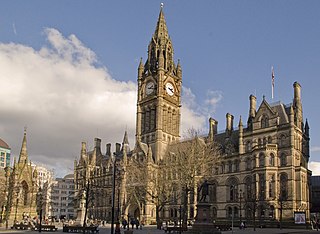
Manchester Town Hall is a Victorian, Neo-gothic municipal building in Manchester, England. It is the ceremonial headquarters of Manchester City Council and houses a number of local government departments. The building faces Albert Square to the north and St Peter's Square to the south, with Manchester Cenotaph facing its southern entrance.
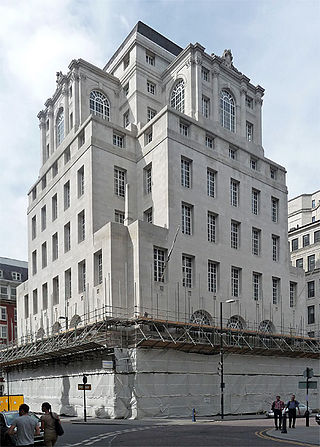
100 King Street, formerly the Midland Bank, is a former bank premises on King Street in Manchester, England. It was designed by Sir Edwin Lutyens in 1928 and constructed in 1933–35. It is Lutyens' major work in Manchester and was designated a Grade II* listed building in 1974.

King Street is one of the most important thoroughfares of Manchester city centre, England. For much of the 20th century it was the centre of the north-west banking industry but it has become progressively dominated by upmarket retail instead of large banks.
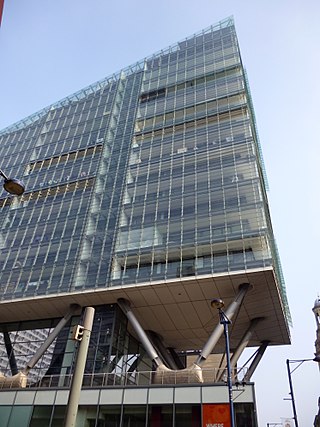
No. 1 Deansgate is the name and location of a medium-rise apartment building in central Manchester, England. It is the tallest all-steel residential building in the United Kingdom, and one of the most expensive addresses in Manchester. The building was completed in 2002, and is situated at the north end of Deansgate close to Manchester Cathedral.
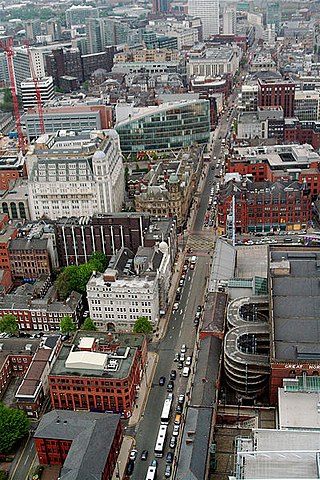
Deansgate is a main road through Manchester City Centre, England. It runs roughly north–south in a near straight route through the western part of the city centre and is the longest road in the city centre at over one mile in length.

Beetham Tower is a 47-storey mixed use skyscraper in Manchester, England. Completed in 2006, it is named after its developers, the Beetham Organisation, and was designed by SimpsonHaugh and Partners. The development occupies a sliver of land at the top of Deansgate, hence its elongated plan, and was proposed in July 2003, with construction beginning a year later.

The Great Northern Warehouse is the former railway goods warehouse of the Great Northern Railway in Manchester city centre, England, which was refurbished into a leisure complex in 1999. The building is at the junction of Deansgate and Peter Street. It was granted Grade II* listed building status in 1974.

The Kimpton Clocktower Hotel is a historic commercial building, now a hotel, at the corner of Oxford Street and Whitworth Street in Manchester, England. The building was originally constructed in segments from 1891 to 1932 as the Refuge Assurance Building.

The architecture of Manchester demonstrates a rich variety of architectural styles. The city is a product of the Industrial Revolution and is known as the first modern, industrial city. Manchester is noted for its warehouses, railway viaducts, cotton mills and canals – remnants of its past when the city produced and traded goods. Manchester has minimal Georgian or medieval architecture to speak of and consequently has a vast array of 19th and early 20th-century architecture styles; examples include Palazzo, Neo-Gothic, Venetian Gothic, Edwardian baroque, Art Nouveau, Art Deco and the Neo-Classical.

Kendals is the previous name of a department store in Manchester, England. Since 2005, the store now operates as House of Fraser. The store had previously been known during its operation as Kendal Milne, Kendal, Milne & Co, Kendal, Milne & Faulkner, Harrods or Watts.

Barton Arcade is a Victorian shopping arcade in Manchester, England, located between Deansgate and St Ann's Square. It was constructed by Corbett, Raby, and Sawyer in 1871.
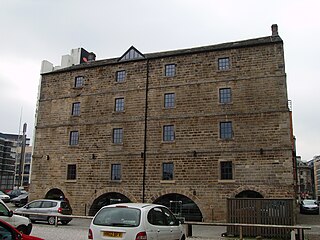
Dale Street Warehouse is an early 19th century warehouse in the Piccadilly Basin area of Manchester city centre, England. It is a Grade II* listed building as of 10 November 1972. It is the earliest surviving canal warehouse in the city. The building is dated 1806 with the initials "WC" on the datestone indicating that it was designed by William Crosley, an engineer who worked with William Jessop on the inner-Manchester canal system.
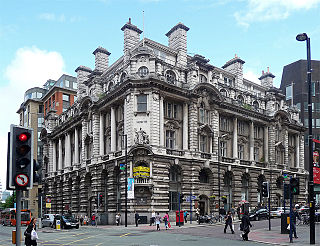
Charles Henry Heathcote was a British architect who practised in Manchester. He was articled to the church architects Charles Hansom, of Clifton, Bristol. He was awarded the RI Medal of Merit in 1868, and started his own practice in 1872.
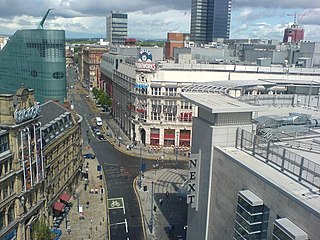
Corporation Street is a major thoroughfare in Manchester city centre, England. It runs from Dantzic Street to the junction of Cross Street and Market Street. Major buildings located on or adjacent to the street include the Arndale Centre, Exchange Square, The Printworks, Urbis and New Century House next to the CIS Tower.

1 The Avenue is a building in Spinningfields, Manchester, England. It is situated on Deansgate adjacent to the Grade I listed John Rylands Library.

Castlefield Congregational Chapel is a building located at 378 Deansgate, Manchester, England. The building originally opened as a Congregational chapel in 1858, and was designed by the local architect Edward Walters. It has been designated by English Heritage as a Grade II listed building. It is located in Castlefield, an Urban Heritage Park.

The Mathematics Building in Manchester, England, was a university building which housed the Mathematics Department of the Victoria University of Manchester and briefly the newly amalgamated University of Manchester from 1968 to 2004. The building consisted of a three-storey podium and an 18-storey, 75 m (246 ft) tall tower. It was designed by local architect Scherrer and Hicks with a combination of 1960s-brutalism and international style modernism architecture. It was demolished in 2005 as the maths department moved to the Alan Turing Building on Upper Brook Street.

Cheetham Hill Road is a road in north Manchester, England, running from Corporation Street in Manchester city centre to Prestwich. In Crumpsall, its name changes to Bury Old Road.

Spring Gardens is an important thoroughfare in Manchester city centre, England. This L-shaped street, formerly the centre of the North West's banking industry, has five Grade II listed buildings and is part of the Upper King Street conservation area.























